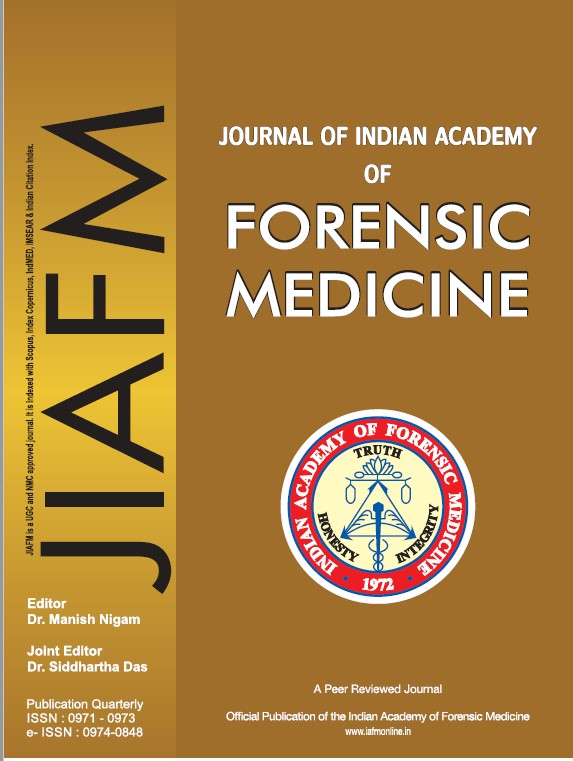Effectiveness of a Teaching Module using Simulated Patient, Photographs and Case Scenario in Wound Certificate Preparation by under-graduate Students
DOI:
https://doi.org/10.48165/jiafm.2024.46.1.5Keywords:
Unnatural deaths, Poisoning, Hanging, Head injury, Multiple injuries, BurnsAbstract
Many mistakes inadvertently made during preparation of wound certificate by doctors could ultimately lead to a miscarriage of justice. As a primary first contact doctor, every Indian Medical Graduate needs to be conversant in the scientific principles of preparation of wound certificate to meet legal requirements. Wound certificates are one of the most compelling medicolegal documents that have for reaching implications in legal trails of homicides, assault and civil injury cases. It is necessary to strengthen the teaching of wound certificate preparation. This study was conducted with an objective to find out the effectiveness of a designated teaching module when compared with conventional method of lecture class. An interventional study done at Department of Forensic Medicine, in a Medical College with whole batch of Phase II MBBS students. Adesigned teaching module with simulated patient, photographs and case scenario was prepared to teach wound certificate. Students were divided into 6 major groups and each group again sub-classified into two; the study group was taught using teaching module and the control group using conventional teaching learning methods. Performance of students was assessed after the teaching schedule and statistically compared using unpaired 't' test. Students taught using teaching module performed better compared to students in a conventional method of teaching where the difference was found to be statistically significant.
Downloads
References
M.A.C.A (Motor Accidents Claims Tribunal) No. 568 of 2008, Against the Award Dated 12.04.2007 in O.P(MV) No. 985/1996 of II Addl. Motor Accidents Claims Tribunal.
Modi JP. History of Forensic Medicine. A Textbook of t h Medical Jurisprudence and Toxicology. 25 ed. Gurgaon: Lexis Nexis; 2017: 3 – 18.
Biswas G. Medico-legal Aspects of injuries. Review of th Forensic Medicine & Toxicology. 4 ed. New Delhi: Jaypee Brothers Medical Publisher; 2019: 302 - 315.
Pillai PS. Examination of Injured Persons. Practical 21
Medicolegal Manual. Indian Academy of Forensic Medicine. Trivandrum. 1988: 41- 51.
Aggrawal A. Salient Features Regarding Medicolegal Certificate. MAMC J Med Sci. 2015;1:45-51 http:// www.mamcjms.in/text.asp?2015/1/1/45/150068
Reddy KSN, Murthy OP. Medicolegal aspects of wounds. The th Essentials of Forensic Medicine & Toxicology. 34 ed. New Delhi: The Health Science Publisher; 2017: 271- 94.
Karmarkar, Sapre DP. Documentation of injuries in hospital records-A study. Journal of Indian Academy of Forensic Medicine.2016; 38(3).287-291 DOI: 10.5958/0974-0848. 2016.00072.5
Sadia S, Shazia Z. Effectiveness of Modular Approach in Teaching at University Level. Journal of Education and Practice. 2014; 5(17). 103- 10.
Murty OP. Modular Teaching in Forensic Medicine and Toxicology. Journal of Forensic Medicine & Toxicology. 2012; 29(1). 1-17.
Shafi R, Quadri KH, Ahmed W, Mahmud SN, Iqbal M. Experience with a theme-based integrated renal module for a second-year MBBS class. Adv Physiol Educ. 2010;34:15-9.
Chavda P, Pandya C, Solanki D, Dindod S. Is “modular” the way to go for small group learning in community medicine in undergraduate clinical postings? Int J Appl Basic Med Res. 2016; 6(3): 211–14.
Karthikeyan K, Kumar A. Integrated modular teaching in dermatology for undergraduate students: A novel approach. Ind Dermat Online Journal. 2014;5(3):266-70. Available from: https://www.ncbi.nlm.nih.gov/pmc/articles/PMC41
/. Accessed on: 2017 June 25.
Kumaran S. Evaluation of the impact of an additional teaching module developed for issuing wound certificate. J Indian Acad Forensic Med. 2018; 40(3). 317-21.
Sufiana KM. Effects of modular and traditional approaches on students' general comprehension. Elixir Social Studies. 2012;42:6228-31.


